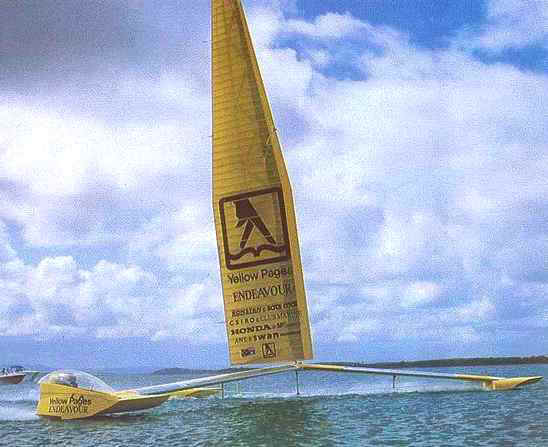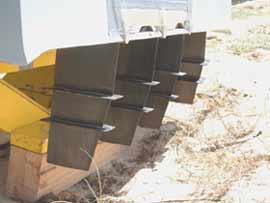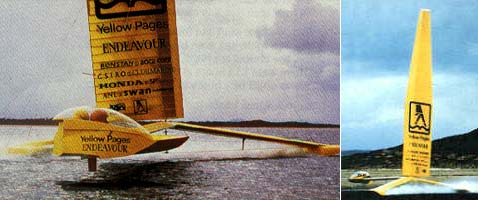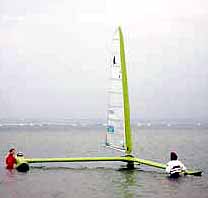|
YELLOW PAGES ENDEAVOUR - YPE
|
|
HOME | BIOLOGY | FILMS | GEOGRAPHY | HISTORY | INDEX | INVESTORS | MUSIC | NEWS | SOLAR BOATS | SPORT |
|
The world record for speed sailing was established back in 1993 at Sandy Point, Australia by Simon McKeon and his vessel Yellow Pages Endeavour, a trimaran.
Yellow Pages Endeavour is highly asymetrical and has three short planing hulls. The one to the right is the lead float, whilst the two on the left are trailing. Two people ride in the upwind float (closest to us in the last picture) which rises out of the water when going at full speed. This boat has 9 small hydrofoils under the pods. The front pods are orientable for steering the boat. YPE uses also a solid wing sail. This boat was designed by Lindsay Cunningham who also designed Australia's repeatedly successful Little America's Cup catamarans.
MAXIMUM SPEED = 86.16 km/h - 53.53 mph - 46.52 knots
Technical Specifications
They have unoffically broken the world record (currently held by by Frenchman Thierry Bielak at 82.7 km/h on a sailboard) by around 1 km/h. They are sailing at Shallow Inlet, a bay 160km south east of Melbourne. The yacht is highly asymetrical, and has three short planing hulls. The one to the right is the lead float, whilst the two on the left are trailing. Two people ride in the upwind float (closest to us in the pic) which rises out of the water when going at full speed.
This boat is designed by Lindsay Cunningham who also designed Australia's repeatedly successful Little America's Cup (C-class) catamarans. The 12m high "sail" on Endeavour is a simplified and "cleaner" (no multi-section foils hence lower drag) version of the solid wing sail used on the C-class yachts. The team plans more attempts early next year.
DESIGN
The design philosophy behind Yellow Pages Endeavour, and now Macquarie Innovation, is based upon the previous world record holders - the sailboards.
The sailboards had been steadily increasing the world mark since the early 80's and Lindsay Cunningham, our team's designer, was convinced that a new craft, based on the sailboard planing hull, could go faster.
Rig design
While there would be a loss in efficiency due to the greater "end loss" from the low aspect rig, this loss was easily compensated for by the reduction in overturning moment. This meant that Macquarie Innovation, when compared to YPE could generate significantly more force before it tipped over. This force was then utilised to drive the boat significantly faster. As a comparison, computer generated velocity prediction simulations predicted that YPE had a maximum top speed of around 49 knots in 19 knots of wind. In the same conditions, Macquarie Innovation should be capable of 58 knots.
Platform design
To complement this massive righting moment, good fore and aft stability was required. In order to reduce windage and water drag, this fore/ aft stability was achieved by setting two planing surfaces approximately 11 metres apart. The angle of the crew beam was set to oppose the line of force of the overturning moment of the sail and balance the relative amounts of downforce on the fore and aft hulls.
The hull sizes were set to ensure adequate buoyancy during the displacement phase of the craft and the width of the planing surface (1.2m) designed to ensure the most efficient planing aspect ratio possible.
Macquarie Innovation was designed around the same principles as YPE. However, to go faster meant a wider and stronger platform was required to handle the increase in performance from the new wing.
Yellow Pages Endeavor — мировой рекордсмен (фотографии с сайтов foxxaero.homestead.com и wingsail.neuralfuzz.com)
Structural design
All aerofoil fairings are constructed using foam and heat shrink cloth. This allows a very lightweight total structure. The total weight of Macquarie Innovation is slightly in excess of 200 kgs.
Foil design
The foils have been thoroughly tested using both computer simulation as well as flow tank testing at the Australian Maritime Engineering facility in Tasmania. With such high design speeds and relatively large loads carried by the foils (each of the four foils experiences the equivalent of an average adult male standing on the end of them), the possibility of experiencing cavitation is real. The section profile is deliberately aimed at delaying the onset of cavitation, thereby ensuring that control is maintained with minimum drag. Two anti-ventilation "fences" also appear on each foil to prevent the low suction pressures from dragging air from the surface down the side of the foil.
French
students led by Malric Leborgne from Southampton Institute built and
raced this wingmasted planing triscaph, inspired by "Yellow Pages
Endeavour,"in 1996. Somewhat smaller, and painted green, she is
known as "Green Pages," or the "Green Machine"
Ha Bourn jól számolt, akkor a hajója az abszolut gyorsasági rekordra (amibe a yachtok, katamaránok, kitesurfök és windsurfök is beleszámítanak) is veszélyes lehet. A Sebességi Vitorlás Rekordok Világtanácsának (bizony, ilyen is van) statisztikái szerint a „vitorlával ellátott bármilyen járművel elért legnagyobb sebesség” kategóriában az ausztrál Yellow Pages Endeavour kétüléses aszimmetrikus trimarán a világelső 46,52 csomóval, azaz 86,16 km/h-val. Ezt még 1993-ban hozta össze Simon McKeon és Tim Daddo, két ausztrál vitorlázó, Melbourne-ben.
Nam
windsurfingowcom prędkość również nie jest obojętna.
Przez jakiś czas mogliśmy się nawet szczycić
rekordem w tej dziedzinie. Thierry Bielak w 1993 roku ustanowił
rekord wynoszący 45,34 węzłów czyli ponad 83 km/h.
Niestety dla Nas, wkrótce po wyczynie Francuza, jego rekord został
poprawiony przez ultra nowoczesny trimaran Yellow Pages Endeavour.
Prędkość osiągnięta przez tę australijską
konstrukcję: 46.52 węzłów (86.52 km/h) do dziś nie
została pobita. A vela el record de velocidad recae también en australianos con el Yellow Pages Endeavour, trimarán planeador que ha alcanzado en 1.993 los 46 nudos durante una distancia de 500 metros, y con sólo unos 20 nudos de viento del través. A partir de 15 nudos de viento empieza a planear y en teoría puede alcanzar 3 veces la velocidad del viento.
Ankstesnis
rekordas 1993 metais:
Healthier alternative tastes for adventure capitalists
Solar Red | Solar Crush | Solar Cola | Solar Spice | Solar +
|
|
This
website
is Copyright © 1999 & 2007 NJK. The bird |
|
AUTOMOTIVE | BLUEBIRD | ELECTRIC CARS | ELECTRIC CYCLES | SOLAR CARS |





